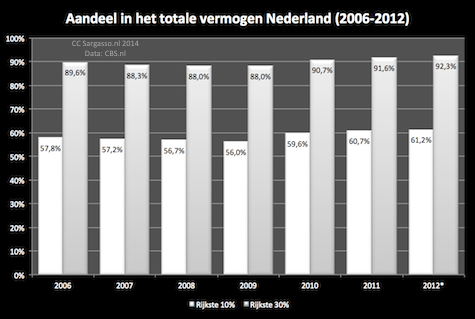ACHTERGROND - Onlangs verscheen in The New York Times een lang commentaar van David Leonhardt gewijd aan het boek van dit moment: Thomas Piketty’s Capital in the Twenty-First Century.
Piketty’s centrale thesis is dat groeiende economische ongelijkheid de historische norm is. De egalitaire, na-oorlogse samenleving (in de VS en West-Europa) is zodoende een historische anomalie. Inmiddels zijn we dan ook weer hard op weg een erfelijke, economische aristocratie te creëren.
Dit betekent tevens dat als we onze relatief egalitaire, ‘onnatuurlijke’ samenleving willen behouden, we daarvoor actief maatregelen moeten treffen. De ‘vrije markt’ gaat dit niet voor ons oplossen.
Het bovenstaande zal voor degenen die alle commentaren en discussie rondom Capital in the Twenty-First Century een beetje hebben bijgehouden niet als een verrassing komen.
Maar waarom neemt economische ongelijkheid onder normale omstandigheden voortdurend toe? Commentator David Leonhardt zocht het voor ons uit:
For all of the clarity of Piketty’s historical analysis, I emerged from the book not quite grasping the mechanics of rising inequality. What is it about market economies that typically cause the assets and incomes of the rich to rise more rapidly than those of everyone else? So I called Piketty at his office in Paris, and he agreed to walk me through it.
He suggested imagining a hypothetical village from centuries ago in which neither the population nor the economy was growing. Every year, the village produced the same amount of goods for the same number of people to divide — a reality that was typical before the Enlightenment, when material living standards and human longevity barely rose. (The peasants of the 15th century were not better off than peasants in ancient Rome.) Even in a zero-growth society, however, assets that helped people produce goods — also known as capital — had value. Capital, Piketty told me, counts as anything “useful, any kind of equipment. Basic tools. Stones in prehistorical times.” Anything, in other words, that “makes people more productive.”
In our hypothetical village, a large farm might produce $10,000 worth of crops in a year and yield $1,000 in profit for its owner. A small farm might have the same 10 percent rate of return: $1,000 in annual crop sales, yielding $100 in profit. If the large farmer and small farmer each spent all of their money every year, the situation could continue ad infinitum, Piketty said, and the rate of inequality in the village would not change.
But one of capital’s great advantages is that its owners can make enough income to spend some of their money and sock the rest of it away. If the large farmer saved $500 of that $1,000 profit, he could buy more capital, which would bring more profit. Perhaps a few owners of smaller farms had debts to pay, and one of the large farmers bought them out. Eventually, the owner of the expanding farm might find himself owning land that yielded $1,500 or $2,000 in annual profit, allowing him to put aside more and more for future capital acquisitions. Less-stylized versions of this story have been playing out for centuries.
I have come to think of this idea as Piketty’s First Law of Inequality. The fact that the rich earn enough money to save money allows them to make investments that other people simply cannot afford. And investments — whether stones, land, corporate stock or education — tend to bring a positive return. Piketty describes the relationship formally as r > g: the rate of return on capital usually exceeds economic growth.

